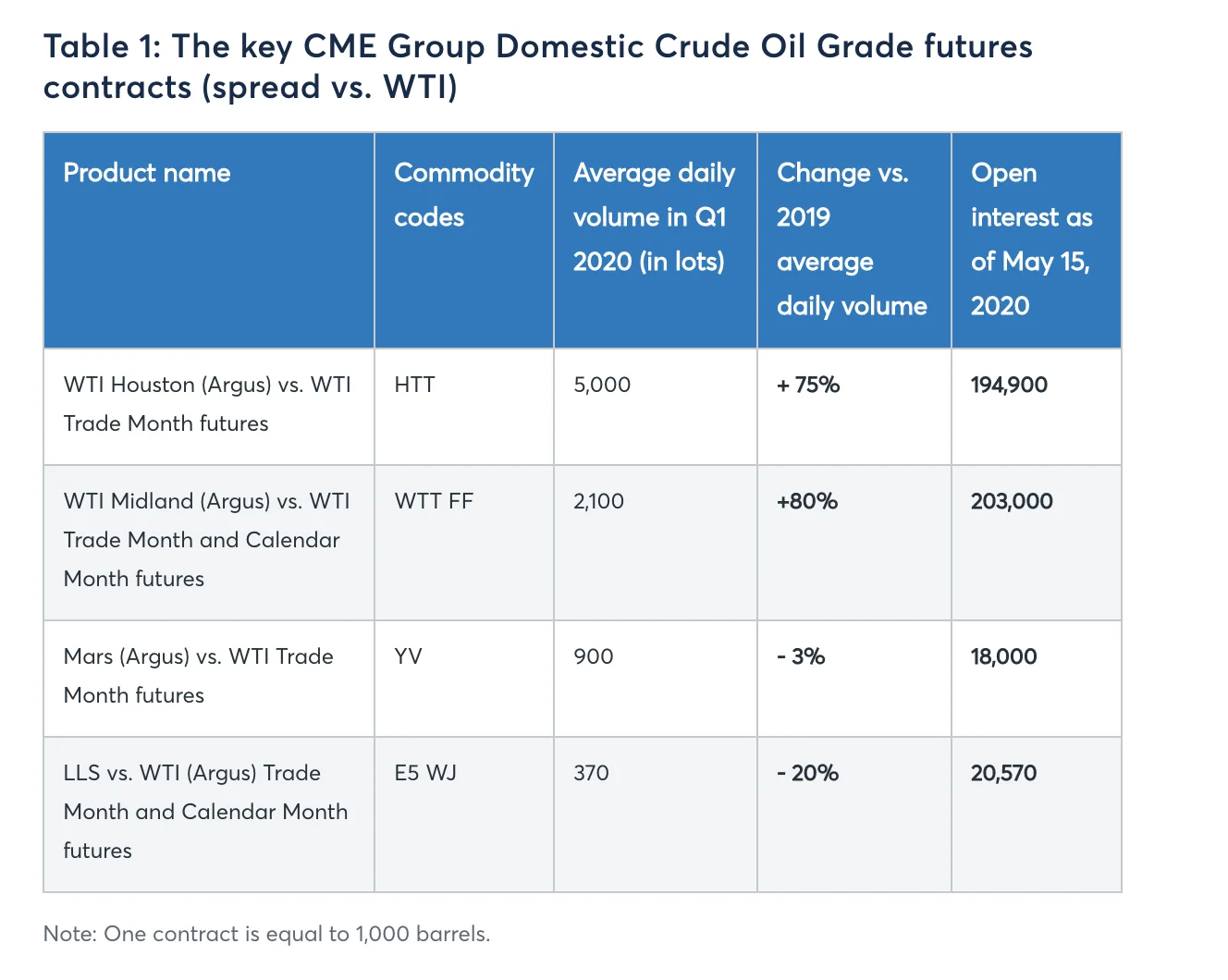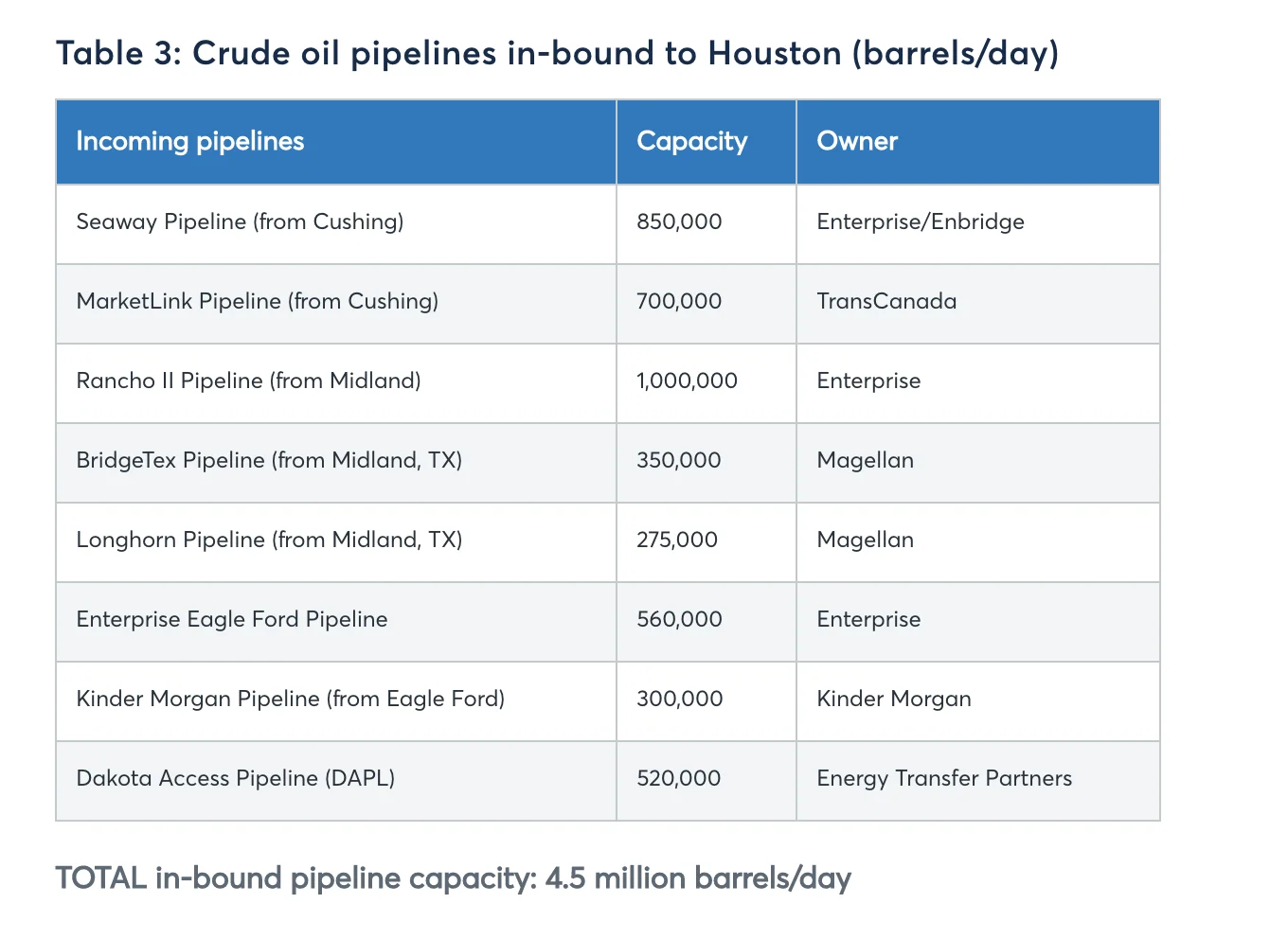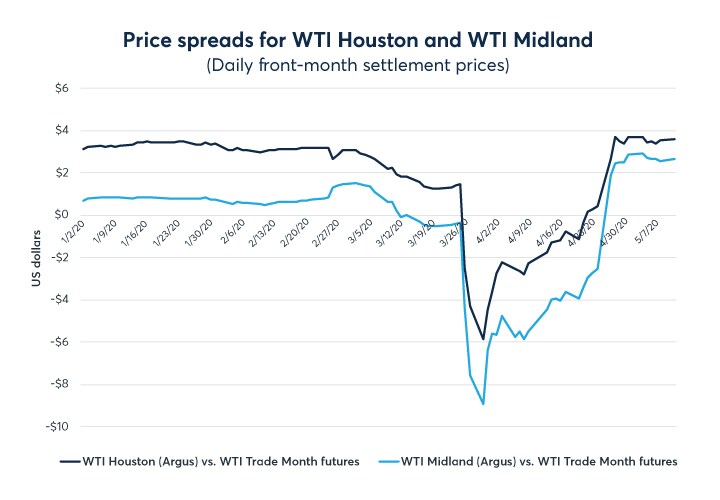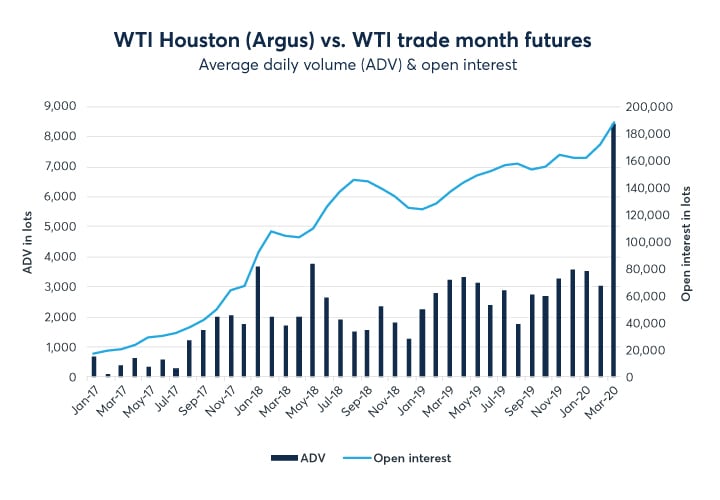
This article was paid for by a contributing third party.More Information.
Tectonic shift in the US domestic crude oil grades market

By Daniel Brusstar and Elizabeth Hui, CME Group
Executive summary
The US domestic crude oil grades market has seen a tectonic shift in the first quarter of 2020 in response to the global demand and supply shocks that flowed from the COVID-19 pandemic and the recent OPEC+ meetings. Consequently, US exports have declined in the short-term, and the arbitrage price signals have responded consistent with the volatile global market fundamentals. One year ago, the major challenge for the Midland trading hub was building additional takeaway pipeline capacity to the US Gulf Coast to access the export markets and to keep pace with the rapid rise in crude oil production in the Permian Basin. Today, the market fundamentals have shifted dramatically, and the resulting price arbitrage has led to a decline in US exports and a reduced flow of crude oil from Midland to the US Gulf Coast.
The price premiums that had previously prevailed for WTI Houston and WTI Midland (versus WTI Cushing) flipped into deep discounts in the first quarter of 2020 as exports dropped and as storage economics attracted barrels from Midland to Cushing. By late April 2020, the price discounts shifted back to price premiums for the WTI Houston and WTI Midland (versus WTI Cushing) spreads. The expanded pipeline infrastructure in the US Gulf Coast and Permian Basin has provided critical optionality to the marketplace, providing an outlet for barrels to flow to the Cushing hub to benefit from the storage economics in lieu of declining export arbitrage in the US Gulf Coast market. In fact, Enterprise Products Partners announced the reversal of one of its twin pipelines on the Seaway system to allow barrels to flow north-bound from the US Gulf Coast to the Cushing hub.
With the expanded pipeline connectivity and volatile export arbitrage, CME Group’s WTI Houston (Argus) vs. WTI trade month futures contract has exhibited strong gains in volume and open interest in the first quarter of 2020. Further, the WTI Midland (Argus) vs. WTI trade month and calendar month futures contracts have shown solid growth in volume and open interest, as the Midland barrels have been pulled to the Cushing market due to the storage incentives via the contango price structure in the NYMEX Light Sweet Crude Oil futures Contract.
Meanwhile, the Mars market has continued to sustain its liquidity as a sour crude oil benchmark in the US Gulf Coast. However, the major infrastructure changes in the US Gulf Coast market have led to a sharp drop in activity in the LLS market.
Market overview
The US domestic crude oil grades market has exhibited dramatic changes due to the volatile price swings in the first quarter of 2020 in response to the global demand and supply fundamentals. Table 1 below shows the recent liquidity trends for the key domestic crude oil futures contracts trading at CME Group. CME Group’s slate of futures contracts for the US domestic crude oil grades are financially settled based on crude oil price assessments published by Argus Media. These cleared futures contracts provide the hedging tools for managing arbitrage risk between the US and global markets.

In response to the volatile global market fundamentals, the US domestic grades have seen large price swings in the first quarter of 2020. The expanded pipeline infrastructure in the US Gulf Coast and Permian Basin has provided strategic optionality to the marketplace, providing alternatives for barrels to flow to the Cushing hub to benefit from the storage economics as the export opportunities decline in the US Gulf Coast market. To visualize the tectonic shift in the US domestic grades market, the price chart below shows the sharp move in the price spreads in March 2020 for WTI Houston and WTI Midland (versus WTI Cushing) which dropped into deep discounts as exports dropped and as storage economics attracted barrels from Midland to Cushing.
The price premium for WTI Midland vs. WTI collapsed from $1.50 per barrel on March 1, 2020, to a steep discount of $9.00 on March 30, 2020. In a similar pattern, WTI Houston vs. WTI made a volatile move from a premium of $3.00 per barrel on March 1, 2020, to a discount of $6.00 at the end of March. By late April, the deep discounts shifted back to price premiums for the WTI Houston and WTI Midland (versus WTI Cushing) spreads. The arbitrage price signals in the US domestic grades market have shifted dramatically in response to the global demand and supply fundamentals, and consequently, the market will seek out the most economic destination for the over-supply of barrels in the global marketplace.
At the same time, the NYMEX Light Sweet Crude Oil futures Contract moved into a “super-contango” price structure during the first quarter of 2020, with the May-June 2020 price spread hitting a record $55.00 per barrel. This price structure has provided a strong incentive to draw barrels into storage at the Cushing hub.
The last period of “super-contango” occurred in early 2009 during the demand destruction after the Lehman bankruptcy, and again in 2011 when the takeaway pipeline capacity in Cushing was constrained prior to the reversal of the Seaway Pipeline in 2012. In response to the tectonic shift in global demand and supply fundamentals, Enterprise Products will allow bi-directional flows on the Seaway Pipeline in April 2020. This will provide flexibility to the marketplace as an outlet for barrels to flow to the Cushing hub to benefit from the storage economics in lieu of the declining export arbitrage in the US Gulf Coast market.
To help understand the tectonic shift in the US domestic grades market and its impact on the international market, an overview of each of the four major crude oil grade benchmarks is provided below.
Overview of the WTI Houston market
There is an active physical crude oil trading center based in Houston, Texas, which is a major hub for storage and pipelines with direct connectivity to the Cushing, Midland, and US Gulf Coast markets. There is active trading in light sweet WTI-type crude oil (also referred to as domestic sweet). The Houston physical delivery mechanism is comprised of a network of nearly a dozen pipelines and 10 major storage terminals.
There are substantial pipeline inflows of WTI-type crude oil to Houston from four major hubs: 1) from Cushing via the Seaway and the TransCanada Marketlink Pipelines; 2) from Midland, Texas via Enterprise’s Sealy Pipelines, the BridgeTex Pipeline and the Longhorn Pipeline; 3) from the Eagle Ford area in Texas via the Enterprise Pipeline and the Kinder Morgan Pipeline; and 4) from the Bakken production region in North Dakota via the Dakota Access Pipeline (DAPL).
The Argus assessment for WTI Houston crude oil is based on delivery at the Magellan terminal in East Houston, which is a key hub for delivery of WTI-type crude oil. The cash market liquidity is vibrant, and market participation is deep.

Overview of the WTI Midland market
There is an active physical crude oil trading center based in Midland, Texas, which is a major hub for barrels produced in the Permian Basin area with direct connectivity to the Cushing and US Gulf Coast markets. Two major pipelines carry crude oil from Midland to Cushing: Basin Pipeline and Centurion Pipeline, with total capacity of 750,000 b/d. In addition, there are multiple pipelines that provide access to the Gulf Coast market in Houston with takeaway capacity of nearly two million b/d.
One year ago, the major challenge for the Midland trading hub was building additional takeaway pipeline capacity to the US Gulf Coast to access the export markets and to keep pace with the rapid rise in crude oil production in the Permian Basin. In March 2020, with the dramatic change in global demand and supply fundamentals, the price arbitrage has shifted and has led to a reduced flow of crude oil from Midland to the US Gulf Coast. In fact, the volatile price arbitrage has re-directed barrels to flow from Midland to Cushing to take advantage of the storage economics. In response to the volatile global market fundamentals in March 2020, the price of WTI Midland (versus WTI Cushing) has dropped into deep discount as US exports have dropped, and as storage economics have attracted barrels from Midland to Cushing. The expanded pipeline infrastructure in the Permian Basin area has provided critical optionality to the marketplace, providing an outlet for barrels to flow into storage at the Cushing hub in lieu of declining export arbitrage in the US Gulf Coast market.
Overview of the Mars market
The Mars market represents spot trade of Mars Blend crude oil which is deliverable at the LOOP facilities in Clovelly, Louisiana. There are significant developments in Louisiana that will impact the Mars market. First, the LOOP facility has begun loading export vessels from its deep-water port that allows for loading of Mars onto VLCC vessels with capacity of 2 to 4 million barrels. This provides direct access for Mars to be exported to the global marketplace, with better arbitrage opportunities for the Mars benchmark.
In addition, Marathon Pipe Line LLC has begun work on the reversal of the Capline system. Previously, Mars flowed northbound to Midwest refineries via the Capline, but these pipeline flows have been terminated. After the reversal is completed, the Capline will provide southbound access for Bakken and heavy Canadian crude oil to flow to the Gulf Coast in direct competition with Mars. This pipeline reversal has significantly altered the logistics in the Mars market, and as a result Mars has become a key export grade from the LOOP terminal.
Figure 1: Capline Pipeline system
Source: Capline Pipeline
The Mars Pipeline System1,2 originates approximately 130 miles offshore in the Deepwater Mississippi Canyon and terminates in salt dome caverns in Clovelly, Louisiana as shown in Figure 6. The System transports offshore crude oil from the Mississippi Canyon area, including the Olympus platform, as well as the Medusa and Ursa pipelines, and from the Green Canyon and Walker Ridge areas via the Amberjack pipeline connection3. It has a capacity of up to 600,000 barrels per day.
In conjunction with the Mars Pipeline System, the Mars infrastructure network consists of a storage cavern with capacity of eight million barrels at the LOOP Clovelly Terminal. This cavern and its interconnection to other LOOP facilities provide a flexible market link to the Gulf Coast pipeline network.
1 https://www.shellmidstreampartners.com/static-files/1a48e4f4-5654-40a9-9e9e-5cef4fa62493
2 http://marketrealist.com/2014/06/must-know-the-assets-of-the-shell-midstream-partners/
3 http://marketrealist.com/2014/07/overview-an-introduction-to-mars-pipelines-expansion-program/
Figure 2: Mars Pipeline system
Overview of the LLS market
The LLS grade is traded at its hub in St. James, Louisiana, which consists of storage facilities and major pipelines for distribution from the Gulf Coast to refineries in Louisiana. There are significant new developments in Louisiana that will impact the logistics around the LLS market. First, Marathon Pipe Line LLC has begun work on the reversal of the Capline system, and the pipeline system has terminated northbound shipments from St. James. As a result, the Capline is no longer available as an outlet for LLS crude oil to flow to refineries in the Midwest market.
When the Capline is finally reversed in 2023, the line will provide access to Bakken and Canadian crude oil to flow southbound from Patoka to the Gulf Coast in direct competition with LLS. The temporary shutdown of Capline has significantly altered the logistics in the LLS market, as market participants seek out additional outlets for LLS in Louisiana and in the export market.
Second, the LOOP facility has completed work to load export vessels from its deep-water port that will allow for loading of LLS onto VLCC vessels with capacity of 2 to 4 million barrels. This will provide access for LLS to be exported to the global marketplace and could provide new arbitrage opportunities for the LLS benchmark.
Light sweet crude produced in the Permian regions in Texas can flow via the Shell Zydeco Pipeline to the hub in St. James and get blended into the LLS stream. The Shell Zydeco Pipeline (also called the Ho-Ho Pipeline) has capacity of 375,000 barrels per day.
Crude oil exports declined in Q1 2020
US crude oil exports declined in the first quarter of 2020 to 3.4 million b/d, down from the peak of 3.7 million b/d recorded in December 2019. The growth in exports has been transformative for the US crude oil market. Houston has become a major export hub, and new infrastructure has been constructed to process the growing export volumes. These infrastructure changes have transformed the US into the marginal supplier of oil to the world.
Figure 5: US crude oil exports peaked in December 2019
US oil production peaked in Q1 2020
US crude oil production peaked in March 2020 at 13.0 million barrels per day (b/d) which is more than double the low of 5.1 million b/d in January 2009. In its report for the week ending May 1, 2020, the US Energy Information Administration (EIA) reported that crude oil production fell by over one million b/d to 11.9 million b/d. In its most recent short-term energy outlook dated May 12, 2020, the EIA forecasts US crude oil production will decline to 11.7 million b/d in 2020, down 0.5 million b/d from 2019. In 2021, EIA forecasts US crude production to decline further by 0.8 million b/d. According to the EIA, most of the US crude oil production is WTI type crude oil with API gravity between 40 and 45 degrees. This is significant for the WTI benchmark, as it underscores the similarity in quality between the new oil production and the WTI pricing reference.
Looking ahead
The US domestic crude oil grades market has been transformed in response due to the demand and supply shocks from the global Covid-19 pandemic and the breakdown of the OPEC+ agreement in March 2020. Consequently, the arbitrage price signals have responded to the global fundamentals, and the US domestic crude oil grades market has provided needed liquidity and greater transparency. The new pipeline infrastructure in the US Gulf Coast and Permian Basin has provided critical optionality to the marketplace, providing an outlet for barrels to flow to the Cushing hub to benefit from the storage economics in lieu of declining export arbitrage in the US Gulf Coast market.
With the expanded pipeline connectivity and higher price volatility, the Exchange’s WTI Houston (Argus) and WTI Midland (Argus) futures contracts have exhibited strong gains in volume and open interest. In addition, the ability to export from the LOOP facility is a game-changer that will provide direct access to the global marketplace and will provide new arbitrage opportunities for the Mars and LLS benchmarks. In addition, the planned reversal of the Capline system in 2023 will significantly alter the logistics in the Gulf Coast market and will impact the pricing of these benchmarks.
In summary, the U.S. domestic crude oil grades are competing in the global marketplace and have become important price references in the international market. The oil market has never experienced anything comparable to the unprecedented market fundamentals that occurred in the first half of 2020. At a time of increased risk and expanded volatility, the ability to hedge price risk has never been so important.
Sponsored content
Copyright Infopro Digital Limited. All rights reserved.
As outlined in our terms and conditions, https://www.infopro-digital.com/terms-and-conditions/subscriptions/ (point 2.4), printing is limited to a single copy.
If you would like to purchase additional rights please email info@risk.net
Copyright Infopro Digital Limited. All rights reserved.
You may share this content using our article tools. As outlined in our terms and conditions, https://www.infopro-digital.com/terms-and-conditions/subscriptions/ (clause 2.4), an Authorised User may only make one copy of the materials for their own personal use. You must also comply with the restrictions in clause 2.5.
If you would like to purchase additional rights please email info@risk.net









